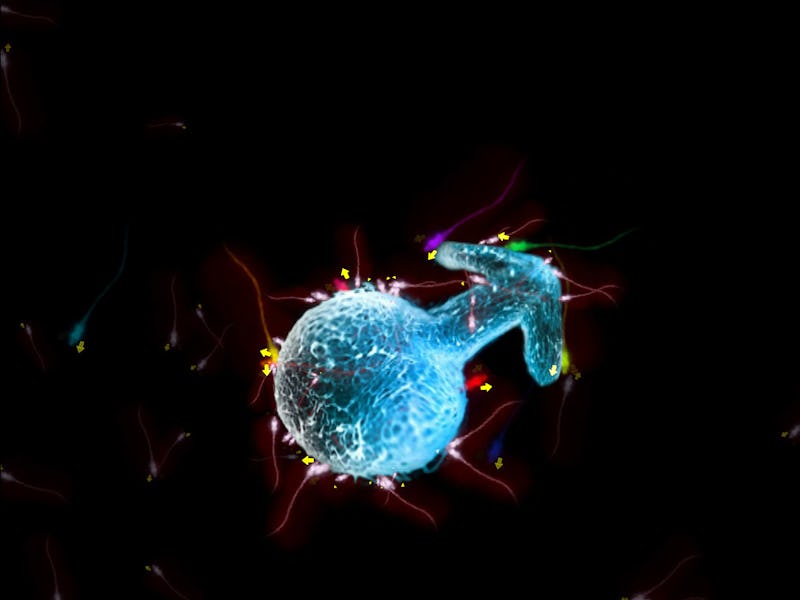Ancient Chinese Medicine Outright Blocks Sperm From Egg
Regular birth control and Plan B all wrapped up in one method, and without any of the annoying side effects.

What if there was a birth control that was hormone-free, 100 percent natural, resulted in no side effects, didn’t harm either eggs nor sperm, could be used in the long-term or short-term, and — perhaps the best part of all — could be used either before or after conception?
Thanks to ancient Chinese folk medicine, that’s not a far-out dream.
Research published Monday in the journal Proceedings of the National Academy of Sciences by scientists at the University of California, Berkeley, identified two plant compounds that could hold the secret to preventing conception.
Here’s how it works: In order to actually penetrate the egg, sperm need to whip their tails faster to pick up momentum. But there are two plant compounds that can prevent sperm from doing this, no matter how valiantly they may try — lupeol, found in mango and dandelion root, and pristimerin, from a plant called the “thunder god vine,” the leaves of which had been used as birth control in traditional Chinese medicine. The sperm and egg are never actually harmed; they’re just never able to meet.
I actually have nothing to add to this.
“Because these two plant compounds block fertilization at very, very low concentrations — about 10 times lower than levels of levonorgestrel in Plan B — they could be a new generation of emergency contraceptive we nicknamed ‘molecular condoms,’” team leader Polina Lishko, an assistant professor of molecular and cell biology, said in a press release. “If one can use a plant-derived, non-toxic, non-hormonal compound in lesser concentration to prevent fertilization in the first place, it could potentially be a better option.”
In previous research, the team had identified progesterone as a key hormone in triggering the sperm tail-whipping, which it facilitates by binding to a protein called ABHD2. While reading up on folk medicines and indigenous methods of natural contraception, they found the lupeol and pristimerin and eventually determined that both work by keeping progesterone and ABHD2 apart. The concentrations of the two substances that exist naturally in plants aren’t high enough for cost-effective commercial birth control, so the researchers are now looking for alternative sources.
Hormone-based birth control methods are generally well-tolerated by most people who take them, but they can also bring accompanying side effects that a lupeol- or pristimerin-based method would not. And even though they could also be used as emergency contraception taken after conception, like Plan B, it’s possible this would be a more palatable option to some who disapprove of Plan B because it can stop fertilized eggs from being implanted and prevent the egg from being fertilized in the first place.
Abstract
The calcium channel of sperm (CatSper) is essential for sperm hyperactivated motility and fertility. The steroid hormone progesterone activates CatSper of human sperm via binding to the serine hydrolase ABHD2. However, steroid specificity of ABHD2 has not been evaluated. Here, we explored whether steroid hormones to which human spermatozoa are exposed in the male and female genital tract influence CatSper activation via modulation of ABHD2. The results show that testosterone, estrogen, and hydrocortisone did not alter basal CatSper currents, whereas the neurosteroid pregnenolone sulfate exerted similar effects as progesterone, likely binding to the same site. However, physiological concentrations of testosterone and hydrocortisone inhibited CatSper activation by progesterone. Additionally, testosterone antagonized the effect of pregnenolone sulfate. We have also explored whether steroid-like molecules, such as the plant triterpenoids pristimerin and lupeol, affect sperm fertility. Interestingly, both compounds competed with progesterone and pregnenolone sulfate and significantly reduced CatSper activation by either steroid. Furthermore, pristimerin and lupeol considerably diminished hyperactivation of capacitated spermatozoa. These results indicate that (i) pregnenolone sulfate together with progesterone are the main steroids that activate CatSper and (ii) pristimerin and lupeol can act as contraceptive compounds by averting sperm hyperactivation, thus preventing fertilization.